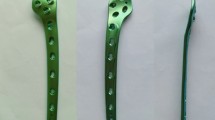Abstract
Objective
To evaluate the effect of locked plate technology to resist torsion in a clavicle fracture model of segmental bone loss.
Methods
Forty-four synthetic clavicles were repaired with either 3.5 mm locked compression plate (LCP) or 3.5 mm low-contact dynamic compression plate (LCDCP). They were divided into two groups of 22 specimens. Each group was tested to evaluate torsional stiffness, load at failure, deflection at failure, and unconstrained plate motion.
Results
LCP group showed significantly greater stiffness in torsion compared to the LCDCP group (p < 0.001). Average difference was 20.9%. Load at failure was not significantly different (p < 0.07). Deflection at failure was significantly less for the LCP group (p < 0.03). Unconstrained motion or plate ‘looseness’ was significantly less for the LCP group (p < 0.017).
Conclusions
In a simulated model of segmental clavicle fracture, a LCP provided more stiffness and less deflection than a low-contact dynamic compression plate.





Similar content being viewed by others
References
Nordqvist A, Petersson C (1994) The incidence of fractures of the clavicle. Clin Ortho 300:127–132
McKee MD, Pedersen EM, Jones C et al (2006) Deficits following nonoperative treatment of displaced midshaft clavicular fractures. J Bone Joint Surg Am 88-A(1):35–40
Hill JM, McGuire MH, Crosby LA (1997) Closed treatment of displaced middle-third fractures of the clavicle gives poor results. J Bone Joint Surg Br 79:537–539
Nowak J, Holgersson M, Larsson S (2005) Sequelae from clavicular fractures are common. Acta Orthop 76(4):496–502
McKee M, Wild L, Schemitsch E (2003) Midshaft malunions of the clavicle. J Bone Joint Surg Am 85A(5):790–797
Canadian Orthopaedic Trauma Society (2007) Nonoperative treatment compared with plate fixation of displaced midshaft clavicular fractures. A multicenter, randomized clinical trial. J Bone Joint Surg Am 89-A(1):1–10
Celestre P, Robertson C, Mahar A et al (2008) Biomechanical evaluation of clavicle fracture plating techniques: does a locking plate provide improved stability. J Orthop Trauma 22(4):241–247
Robertson C, Celestre P, Mahar A, Swartz A (2009) Reconstruction plates for stabilization of mid-shaft clavicle fractures: differences between nonlocked and locked plates in two different positions. J Shoulder Elbow Surg 18:204–209
Iannotti M, Crosby L, Stafford P et al (2002) Effects of plate location, selection on the stability of midshaft clavicle osteotomies: a biomechanical study. J Shoulder Elbow Surg 11:457–462
Heiner AD, Brown TD (2001) Structural properties of a new design of composite replicate femurs, tibias. J Biomech 34:773–781
Cristofolini L, Viceconti M (2000) Mechanical validation of whole bone composite tibia models. J Biomech 33:279–288
Cristofolini L, Viceconti M, Cappello A, Toni A (1996) Mechanical validation of whole bone composite femur models. J Biomech 29(4):525–535
Mazzocca AD, Caputo AE, Browner BD, Mast JW, Mendes MW (2003) Principles of internal fixation in skeletal trauma. In: Browner BD, Jupiter JB, Levine AM, Trafton PG (eds) Skeletal trauma: basic science, management, and reconstruction, 3rd edn. Saunders Philadelphia, PA, p 215
Sahara W, Sugamoto K, Murai M et al (2007) Three-dimensional clavicular and acromioclavicular rotations during arm abduction using vertically open MRI. J Orthop Res 25:1243–1249
Ludewig PM, Behrens SA, Meyer SM et al (2004) Three-dimensional clavicular motion during arm elevation: reliability and descriptive data. J Orthop Sports Phys Ther 34:140–149
Warner JJP (2009) Audio-Digest Orthopaedics 32(2). http://www.cme-ce-summaries.com/orthopaedics/or3202.html
Bowman SM, Zeind J, Gibson LJ et al (1996) The tensile behavior of demineralized bovine cortical bone. J Biomech 29(11):1497–1501
Klos K, Sauer S, Hoffmeier K et al (2009) Biomechanical evaluation of plate osteosynthesis of distal fibula fractures with biodegradable devices. Foot Ankle Int 30(3):243–251
Stoffel K, Dieter U, Stachowiak G, Gachter A, Kuster MS (2003) Biomechanical testing of the LCP–how can stability in locked internal fixators be controlled? Injury 34(Suppl 2):B11–B19
Hipps JA, Hayes WC (2003) Biomechanics of fractures. In: Browner BD, Jupiter JB, Levine AM, Trafton PG (eds) Skeletal trauma: basic science, management, and reconstruction, vol 1, 3rd edn. p 112
Filipowicz D, Lanz O, McLaughlin R et al (2009) A biomechanical comparison of 3.5 locking compression plate fixation to 3.5 limited contact dynamic compression plate fixation in a canine cadaveric distal humeral metaphyseal gap model. Vet Comp Orthop Traumatol 22(4):270–277
Greiwe RM, Archdeacon MT (2007) Locking plate technology: current concepts. J Knee Surg 20(1):50–55
Smith WR, Ziran BH, Anglen JO, Stahel PF (2007) Locking plates: tips and tricks. J Bone Joint Surg 89A(10):2298–2307
Bottlang M, Doornink J, Fitzpatrick DC, Madey SM (2009) Far cortical locking can reduce stiffness of locked plating constructs while retaining construct strength. J Bone Joint Surg 91(A):1985–1994
Inman VT, Saunders JB, Abbott LC (1994) Observations of the function of the shoulder joint. J Bone Joint Surg Am 26A:1–30
Yinger K, Scalise J, Olson S et al (2003) Biomechanical comparison of posterior pelvic ring fixation. J Orthop Trauma 17:481–487
Adamczyk MJ, Odell T, Oka R (2007) Biomechanical stability of bioabsorbable screws for fixation of acetabular osteotomies. J Pediatr Orthop 27:314–318
Amander MW, Reeves A, MacLeod IAR et al (2008) A biomechanical comparison of plate configuration in distal humerus fractures. J Orthop Trauma 22(5):332–336
Lee SS, Mahar AT, Miesen D et al (2002) Displaced pediatric supracondylar humerus fractures: biomechanical analysis of percutaneous pinning techniques. J Pediatr Orthop 22:440–443
Acknowledgments
This study was underwritten by a grant from Synthes, Inc. (Paoli, PA). The authors also recognize Dr. Steven Goldstein (U. Michigan) for his guidance and Mr. Jonathan Heifetz (Presque Isle Orthopedic Lab, Erie, PA) for his assistance with specimen preparation.
Author information
Authors and Affiliations
Corresponding author
Rights and permissions
About this article
Cite this article
Will, R., Englund, R., Lubahn, J. et al. Locking plates have increased torsional stiffness compared to standard plates in a segmental defect model of clavicle fracture. Arch Orthop Trauma Surg 131, 841–847 (2011). https://doi.org/10.1007/s00402-010-1240-y
Received:
Published:
Issue Date:
DOI: https://doi.org/10.1007/s00402-010-1240-y




